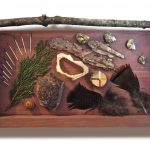Lew Minter “Nature: Relationships and Spirits”
 The Reliquary Series of wall sculptures contains natural elements that we see all the time, but whose beauty and majesty we rarely pause to contemplate. The contrast between the man-made box and the natural elements symbolizes the separation of the physical and spiritual worlds. The elements relate to one another in a manner that symbolizes the rhythm of life as well as the interconnection of all things in nature. Each box includes a small symbol from our Native American culture that represents a particular aspect of life. These boxes pay homage as well to the reverence and respect Native Americans had, and still have, for nature; they utilize those elements in their lives, clothing, medicines, homes, food, weapons, and religious objects—even in the toys they provide for their children. In this culture, we are not the masters of nature but, simply, a part of the matrix. These boxes have a dark side, however: If we don’t take more responsibility for our environment, the boxes will be all we have left. There is a Native American saying: “We do not inherit the earth from our ancestors, we borrow it from our children.” Since I am part Iroquois, these are an homage to that part of my heritage as well. The boxes are intended to be meditative objects for the viewer as they are for me when I make them.
The Reliquary Series of wall sculptures contains natural elements that we see all the time, but whose beauty and majesty we rarely pause to contemplate. The contrast between the man-made box and the natural elements symbolizes the separation of the physical and spiritual worlds. The elements relate to one another in a manner that symbolizes the rhythm of life as well as the interconnection of all things in nature. Each box includes a small symbol from our Native American culture that represents a particular aspect of life. These boxes pay homage as well to the reverence and respect Native Americans had, and still have, for nature; they utilize those elements in their lives, clothing, medicines, homes, food, weapons, and religious objects—even in the toys they provide for their children. In this culture, we are not the masters of nature but, simply, a part of the matrix. These boxes have a dark side, however: If we don’t take more responsibility for our environment, the boxes will be all we have left. There is a Native American saying: “We do not inherit the earth from our ancestors, we borrow it from our children.” Since I am part Iroquois, these are an homage to that part of my heritage as well. The boxes are intended to be meditative objects for the viewer as they are for me when I make them.
The observations of nature are true, too, of the Spirits of the Woods Series of digital prints. In these, I start with photographs of wooded areas. I refer to the pattern formed by the trees as an organic grid. Within this grid, I pull out shapes, applying color and a different texture to suggest amorphous figures or spirits that, in our culture, inhabit the woods, if we will only observe and listen. Native Americans believe that everything possesses a spirit we can learn from if we pay close attention. As with the Reliquary Series boxes, these digital prints are offered as objects of meditation.
Lew Minter, 2012